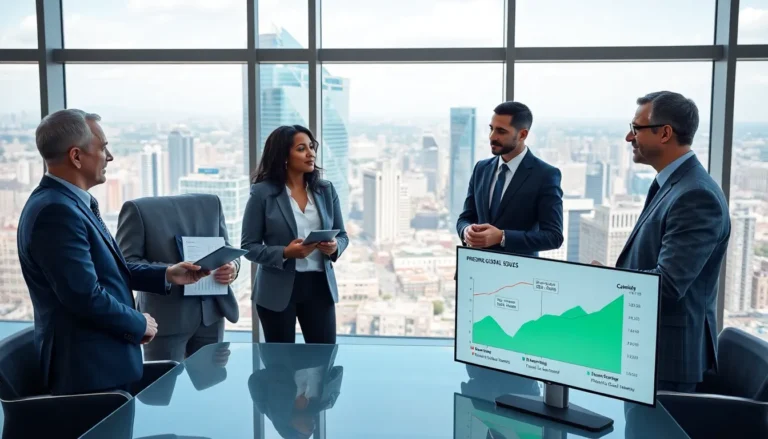Table of Contents
ToggleIn a world overflowing with digital noise, the power of a stunning magazine layout can’t be underestimated. It’s like the perfect outfit for your content—captivating, stylish, and impossible to ignore. Creative magazine layouts don’t just present information; they weave a visual story that draws readers in and keeps them flipping pages, or in today’s world, scrolling through screens.
Overview of Creative Magazine Layouts
Creative magazine layouts play a crucial role in attracting and retaining reader attention. These layouts differ from traditional designs by incorporating innovative elements like bold typography, distinct color schemes, and unique grid structures. Effective use of space enhances readability and encourages exploration, creating a dynamic experience for readers.
Visual storytelling emerges as a key component in these layouts. Through the strategic placement of images and text, magazines can convey complex narratives quickly. Engaging visuals capture interest while supporting the written content, bridging the gap between aesthetics and information.
Varied layouts cater to different themes and audiences. For instance, fashion magazines often embrace lavish images alongside minimal text, fostering a luxurious feel. Conversely, news publications may opt for more structured layouts to deliver information efficiently.
Flexibility is vital in modern magazine design. Digital formats allow for interactive elements such as animations and hyperlinks, enriching the reader’s journey. By adapting to various platforms, magazines can maintain relevance in an evolving media landscape.
Adopting unique design trends helps magazines stand out. Techniques like asymmetrical layouts, layered textures, and mixed media create visual interest. Such creativity not only enhances the overall artistic appeal but also aligns with contemporary design preferences.
Creative magazine layouts serve more than just aesthetic purposes; they invite readers into a captivating world of information and design. By prioritizing innovative elements, magazines can forge a deeper connection with their audience and foster continued engagement.
Key Elements of Creative Magazine Layouts

Creative magazine layouts thrive on several key elements that enhance their visual appeal and reader engagement. These aspects encapsulate typography, imagery, and color schemes, forming a foundation for captivating designs.
Typography
Typography plays a pivotal role in conveying a magazine’s tone and personality. Bold fonts can emphasize headlines while elegant scripts may suggest sophistication. Hierarchy matters, influencing how readers navigate content. Combining font styles and sizes creates visual interest. For example, mixing serif and sans-serif fonts enables contrast and clarity. Consistency in font usage establishes brand identity. Overall, balanced typography not only enhances readability but also enriches the overall aesthetic.
Imagery
Imagery enhances the storytelling experience within a magazine. High-quality photos capture attention and evoke emotions, guiding the reader’s journey. Strategic placement of images complements text and illustrates key points. Galleries or full-page photos can establish themes, invigorating layouts with dynamic visuals. Diverse image formats, such as illustrations or infographics, add versatility. Additionally, cohesive imagery unifies content, ensuring a seamless transition between topics. Compelling visuals bolster engagement, making readers more likely to explore further.
Color Schemes
Color schemes significantly affect a magazine’s mood and design impact. Harmonious palettes create cohesion and attract attention. For instance, warm colors evoke energy, while cool tones offer calmness. Unique combinations can distinguish brands and draw in target audiences. Utilizing accents helps highlight critical information and create focal points. Strategically using color can guide reading flow and enhance navigation. Ultimately, effective color choices allow magazines to communicate emotions and strengthen the visual narrative.
Types of Creative Magazine Layouts
Creative magazine layouts come in various styles, each serving distinct purposes and capturing different audiences’ attention. This section explores three notable types of layouts.
Minimalist Layouts
Minimalist layouts emphasize simplicity and clean design. Such designs minimize distractions, allowing content to take center stage. Space plays a crucial role in enhancing focus and clarity. A limited color palette and a thoughtful selection of fonts contribute to a cohesive aesthetic. This layout effectively targets readers who appreciate artful simplicity, making it ideal for lifestyle and design magazines.
Dynamic Grid Layouts
Dynamic grid layouts introduce a sense of movement and structure. Flexible grid systems allow for varied text and image placements, creating an engaging visual experience. Balanced spacing and modular components enable easy navigation within the content. This layout effectively caters to diverse themes, making it suitable for both fashion and travel publications. Readers enjoy the visual rhythm, which guides their exploration through the pages.
Asymmetrical Layouts
Asymmetrical layouts challenge traditional designs. These layouts break conventions by placing elements in unconventional arrangements. Unique placements create visual interest and draw attention to important content. Designers often mix images, text, and negative space for a striking effect. This approach resonates with innovative brands and art-focused magazines, appealing to audiences seeking fresh perspectives.
Techniques for Creating Engaging Layouts
Creative layouts engage readers by thoughtfully using design elements. Effective strategies enhance visual appeal and improve reader retention.
Use of White Space
White space plays a vital role in magazine design. It allows elements to breathe, preventing visual clutter. Strategic gaps between images and text help focus attention on key content. They enhance readability by creating a clean and organized look. White space can highlight important information, allowing readers to absorb content more easily. Magazines that excel in using white space often create a more inviting and comfortable experience for readers. Empty areas contribute to the overall aesthetic, balancing vibrant visuals and extensive text.
Incorporating Visual Hierarchy
Visual hierarchy guides reader attention efficiently throughout a magazine. Designers can manipulate size, color, and placement to establish which elements are most important. A larger headline captures initial interest, while supporting text remains smaller and secondary. Establishing a clear visual path through layouts encourages exploration of the entire piece. Color differences can draw readers’ eyes towards critical information, creating a flow that’s intuitive. Utilizing varying font weights further reinforces this hierarchy, allowing readers to grasp the content quickly. Effective visual hierarchy ensures that essential messages receive the attention they deserve.
Creative magazine layouts are essential in captivating readers and enhancing their experience. By blending innovative design elements with effective visual storytelling, magazines can create a unique narrative that resonates with their audience.
The thoughtful integration of typography, imagery, and color schemes not only elevates the overall aesthetic but also reinforces the magazine’s identity. As various layout types cater to specific themes and audiences, they enable brands to stand out in a crowded market.
Ultimately, embracing creativity and flexibility in magazine design fosters deeper connections with readers, encouraging them to engage with the content on a more meaningful level. This approach not only attracts attention but also cultivates lasting loyalty among audiences.





